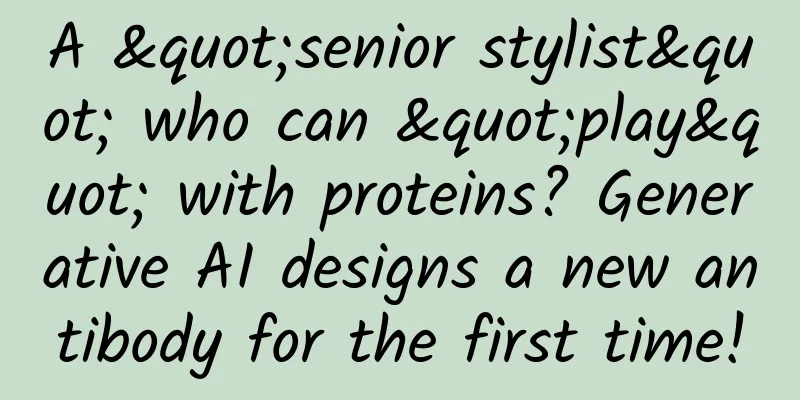A "senior stylist" who can "play" with proteins? Generative AI designs a new antibody for the first time!

|
The field of protein design has reached another milestone. The "Hand of God" team of David Baker, professor of biochemistry at the University of Washington, and their collaborators used generative artificial intelligence (AI) technology for the first time to design a new antibody from scratch , pushing antibody therapy to a whole new level. The work raises the possibility of bringing AI-driven protein design to the hundreds of billions of dollars market for therapeutic antibodies, Nature reported. Figure | Antibodies (pink) bind to influenza virus proteins (yellow) (artistic concept). (Source: Juan Gaertner/Science Photo Library) The related research paper, titled "Atomically accurate de novo design of single-domain antibodies", has been published on the preprint website bioRxiv. “This is a very promising study that represents an important step forward in applying artificial intelligence protein design tools to the creation of new antibodies ,” said Charlotte Deane, an immunoinformatician at the University of Oxford in the United Kingdom. Making antibody design faster and easier Antibodies are immune molecules that can strongly attach to disease-associated proteins. Traditional methods of making them involve immunizing animals or screening large numbers of molecules, which are expensive and time-consuming. Being able to short-circuit these expensive AI tools has the potential to “democratize the ability to design antibodies,” says Nathaniel Bennett, a computational biochemist at the University of Washington and co-first author of the paper. In this work, the research team used RFdiffusion and RoseTTAFold2 networks, through computer simulation and experimental verification, and successfully designed a new antibody VHH (single domain antibody; Variable Heavy-chain of Heavy-chain antibodies). Throughout the design process, the research team fully considered the interaction between antibodies and targets, striving to achieve the optimal binding effect. According to the paper, RFdiffusion and RoseTTAFold2 networks play a crucial role in antibody design, realizing the design and prediction of antibody structure and providing a basis for the generation of new antibodies. Among them, the RFdiffusion network is mainly used to design new antibody structures, especially for specific antigen epitopes. It can design antibody structures with binding ability based on the antigen epitopes specified by the user. Based on the protein backbone of AlphaFold2/RF2, the RFdiffusion network uses a series of training processes to predict and optimize protein structure. During training, the network goes through a series of steps to de-noise the protein structure and predict the denoised structure. These steps allow the network to learn and optimize the antibody structure to fit a specific antigen epitope. Through the training and optimization process, the network is able to generate antibody structures with high binding affinity, thereby achieving recognition and binding to specific antigens. Figure | Overview of RFdiffusion for antibody design. (Source: This paper) The RoseTTAFold2 network is mainly used to predict antibody structures, especially antibody structures in antibody-antigen complexes. It can help verify whether the binding mode of the designed antibody structure and antigen is in line with expectations. Based on the Transformer neural network architecture, the RoseTTAFold2 network is trained using a large amount of protein structure data. It predicts protein sequences from sequence to sequence to obtain a new protein 3D structure. Figure | The fine-tuned RoseTTAFold2 can distinguish between true complexes and decoy complexes. (Source: This paper) Figure | Comparison of fine-tuned RoseTTAFold2 and IgFold in antibody monomer prediction. (Source: the paper) By predicting the designed antibody structure, the research team can better understand the interaction between antibodies and antigens and verify the rationality and effectiveness of the design. Overall, by designing and predicting antibody structures, RFdiffusion and RoseTTAFold2 networks provide important support for the innovation and validation of new antibodies. Can antibodies designed by artificial intelligence be used? Using this approach, the team designed thousands of antibodies that recognize specific regions of several bacterial and viral proteins (such as the protein that the influenza virus uses to invade cells) as well as a cancer drug target. They then made a subset of these designs in the lab and tested whether the molecules bound to the correct targets, validating the antibodies' remarkable effectiveness. For example, technologies such as surface plasmon resonance (SPR) can verify the binding ability of VHH to the target antigen. Experimental results show that the designed VHH can specifically bind to the target antigen and exhibit a certain binding affinity. In addition, X-ray crystallography and/or cryo-electron microscopy can be used to analyze the complex structure of VHH and target antigen. The structural analysis results show that the designed VHH forms a specific binding mode with the target antigen, and the key residues of VHH interact specifically with the antigen epitope, further proving that the designed antibody has the ability to bind to the target antigen. Finally, the research team verified the binding affinity between VHH and the target antigen through SPR and other technologies. The results showed that there was a certain binding affinity between the designed VHH and the target antigen, and its affinity value reflected the binding strength and stability between the two. The above results provide important experimental basis and support for the further application and development of the designed antibodies. However, this study also has some limitations. First, the designed VHH still needs to be further optimized and improved in terms of binding affinity and specificity; second, the designed VHH has been mainly verified for a single antigen, and the therapeutic effect for multiple antigens or complex diseases has yet to be verified; in addition, the immunogenicity, stability and production cost of antibodies also need further research and resolution. Protein design, full of possibilities In recent years, David Baker's team has been committed to protein design research and has achieved remarkable results. Photo: David Baker In August 2021, the team developed a completely free, new deep learning tool, RoseTTAFold, which not only has the ultra-high accuracy of protein structure prediction comparable to AlphaFold2, but is also faster and requires less computer processing power. In November 2021, the team further combined AlphaFold 2 with RoseTTAFold and successfully used it to predict protein-protein complex structures. In April last year, they published a paper in Science, describing how to use reinforcement learning to design a new protein design software. The proteins synthesized by this method can more effectively produce useful antibodies in mice. They said that this breakthrough will contribute to the field of vaccines. Last July, they developed an artificial intelligence protein structure prediction system RoseTTAFold, which they claim is comparable to AlphaFold and can predict not only protein structure but also protein complex structure. Subsequently, they also released the cloud version of RFdiffusion, bringing customized proteins into the mainstream scientific research community. Last December, the team published a paper in Nature demonstrating that artificial intelligence technology can design high-affinity proteins from scratch, making it more likely that scientists will create cheaper antibody alternatives for disease detection and treatment. A good scientific research requires not only solid technology but also rich imagination. In the future, the field of antibody and protein design may be full of infinite possibilities, bringing new hope to human health and medical treatment. Reference Links: https://www.biorxiv.org/content/10.1101/2024.03.14.585103v1https://www.nature.com/articles/d41586-024-00846-7 |
<<: If you are bitten by a five-step snake, how many steps are safest to take?
>>: The best vegetables to eat in spring have so many benefits!
Recommend
How to do new media promotion? Real estate planning case details
Introduction: Interactive content and full networ...
Weijing CEO Li Huaiyu: VR is definitely the next trillion-dollar trend
Article source: Internet Hotspot Introduction: Th...
GSMA: Benefits of 5G deployment in Russia
GSMA releases new report 'The benefits of 5G ...
Pork also has health advantages! Eating it right can replenish your nutrition
Many people believe that chicken and beef are hea...
Experience and skills in writing e-commerce marketing plans!
Everyone in the e-commerce industry knows that th...
Watch the ever-changing Earth from afar: How are meteorological satellites launched?
The launch vehicle gives the artificial satellite...
Exploring the poles for 80,000 miles and crossing three oceans: What tremendous changes has China’s polar survey development undergone?
01 Introduction to the Polar Regions The Arctic r...
How much is the first recharge for Baidu promotion in Suzhou?
The general price is 6200, in some areas it is 74...
Disassembling the core parameters of home projectors, choosing a projector with three-color laser light source in mind
There is no doubt that this is the era of the exp...
Is it okay to charge your phone overnight without unplugging it? This article will tell you
High-power fast charging is gaining popularity ve...
How does Haidilao improve its user retention rate?
The 2019 performance report of catering industry ...
How do educational platforms acquire customers at low cost?
Under the epidemic, the market investment cost of...









